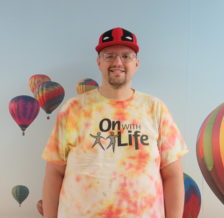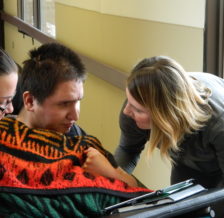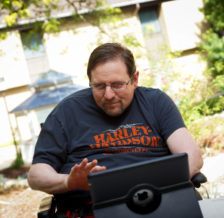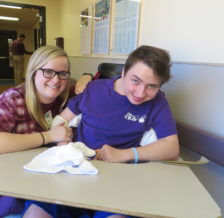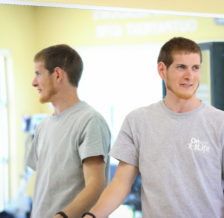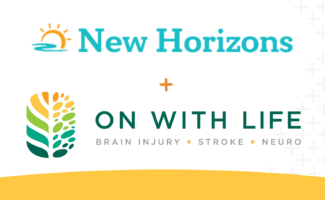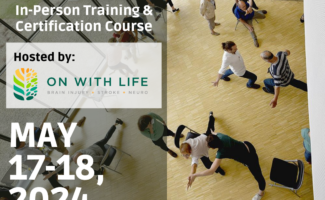Programs + Services
- Homepage
- >
- Programs + Services
- >
- Stroke
Stroke
-
0X X
More therapy hours per week for our inpatient persons served compared to other skilled nursing facilities
Overcoming is always underway.
Stroke can affect many aspects of life, including movement, communications, reasoning, balance, swallowing, speech and even breathing. Depending on the severity of the stroke, different areas of the brain can be affected. At On With Life, we understand that because each individual is different in how the stroke has affected them, that each rehabilitation plan needs to be different. The focus of the program is to identify each participant’s personal goals and needs and prioritize interventions in a manner designed to support improved outcomes and community involvement.
Stroke Program Overview
Stroke Education and Information
What is a Stroke?
A stroke occurs when the flow of blood and oxygen to the brain is interrupted by a blood clot or a broken blood vessel. Brain cells in the immediate area then die, often causing physical and emotional disabilities, including speech problems, memory loss and paralysis.
There are two types of strokes that can occur. An ischemic stroke is when a clot blocks the blood supply to the brain and a hemorrhagic stroke is when a blood vessel in the brain bursts and bleeding occurs.
Signs of stroke include sudden numbness or weakness of the face, arms or legs, especially on one side of the body; sudden confusion or trouble speaking or understanding others; sudden changes in vision or trouble seeing in one or both eyes; sudden trouble walking, dizziness or loss of balance or coordination; and sudden severe headache with no known cause.
Risk Factors
Preventing and controlling stroke risk are the most important steps in reducing a person’s risk for having a stroke. Common risk factors include age, gender, ethnicity, high blood pressure, heart disease, atrial fibrillation, high blood cholesterol levels, diabetes, tobacco use, alcohol use, physical inactivity, and obesity. Women and African-Americans face an increased risk of stroke. In addition, 25 percent of strokes occur in people under the age of 65, according to the American Stroke Association.
- Blood Pressure Management: Be aware of where your blood pressure is, have it checked regularly either at your physician’s office, the local pharmacy or a home blood pressure cuff. If you are noticing you blood pressure is on the high side, let your physician know.
- Smoking and Alcohol: Smoking doubles your risk of stroke. Stopping smoking can significant decrease your risk of a stroke. Visit with your physician about ways to quit smoking. Alcohol actually affects your blood pressure, so limiting your alcohol intake can impact your blood pressure positively. Drink in moderation (no more than two drinks a day)
- Atrial Fibrillation Awareness: This is an irregular or abnormal heartbeat that sometimes happens and causes blood to pool in the heart – causing clots that in turn can cause a stroke. Regular checkups with your physician will help to monitor for this.
- Cholesterol Levels: Yearly checkups with your physician will help you to monitor your cholesterol, a fatty substance that can clog your arteries and cause a stroke.
- Diabetes: Diabetics increase your risk of stroke, so managing your blood sugar levels is important, as well as monitoring for any complications from diabetes.
Prevention and Awareness
Stroke is one of the most preventable of all life-threatening health problems. Learning the signs of stroke and working with a primary care doctor to manage stroke risk factors will lead to fewer incidences of stroke and disability. Recognizing the warning signs of stroke and immediately calling for emergency medical care are critical to preventing death and disability in persons having a stroke.
Regularly see your physician and have annual physicals is to monitor your cholesterol, blood pressure, weight, and overall health. Choosing healthy meal and snack items (like fruits and vegetables), foods low in saturated fat and cholesterol as well as high in fiber can improve your blood cholesterol (decreasing the fats in your blood decreases risk of stroke). In addition, be sure to limit your sodium intake (this will help keep your blood pressure down).
Being overweight can increase your risk of stroke. Get moving and be active to help prevent stroke. It will also help you maintain your weight, lower your cholesterol and blood pressure.
Warning Signs
To help minimize the effects of a stroke, treatment must be given within three hours of the first symptom. Immediate emergency medical attention is vital in the event of a stroke. The National Stroke Association developed the F.A.S.T. test to check for stroke signs in the face, arms and speech and to remind people that time is an important factor in the treatment of stroke. F.A.S.T. stands for:
- FACE: Ask the person to smile. Does one side of the face droop?
- ARMS: Ask the person to raise both arms. Does one arm drift downward?
- SPEECH: Ask the person to repeat a simple sentence. Are words slurred or repeated incorrectly?
- TIME: If the person shows any of these symptoms, time is important. Call 911 or get to the hospital fast.
